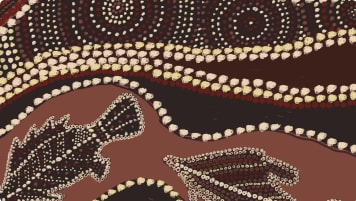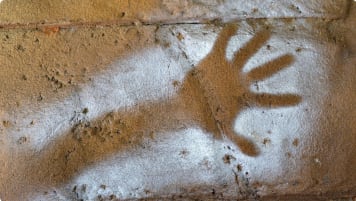Albany Fish Traps, Western Australia
Articles supporting small group tours for senior and mature travellers, couples and solo travelers learning about Aboriginal and colonial history. A large body of archaeological sites specifically associated with Aboriginal estuarine fishing and fishtraps lie scattered across the southwest of Western Australia.
20 Mar 21 · 7 mins read

Albany Fish Traps
A large body of archaeological sites specifically associated with Aboriginal estuarine fishing lie scattered across the southwest of Western Australia. The most comprehensive of these are confined to the 130km long shoreline between Broke Inlet and King George Sound on the Southern Ocean coast. Here are some 40 stone structures, interpreted as weirs or fish traps, built over six thousand years ago. Nearly all are located on the foreshores at three estuaries: Oyster Harbour, Wilson Inlet, and Broke Inlet.
The Albany fish traps, also known as the Oyster Harbour Fish Traps, are the best known of these fishing sites, and the only ones well-documented by early European explorers in the late eighteenth and early nineteenth century. These are a series of traps located on the northern shore of Oyster Harbour, a 16km² estuarine basin opening into King George Sound, near the mouth of the Kalgan River. They were built by the Menang Noongar people to catch fish at low tide, playing a significant role in subsistence strategies, and today continue to hold an important place in local Aboriginal culture.
This article explores the Albany Fish Traps as practical knowledge for a number of Odyssey Traveller small group tours in Australia. It is part of a continuing series of pieces on Aboriginal culture and settlement and ancient landscapes of Australia. An appreciation of Indigenous activity is recognised as an important facet of learning in out tours, a part of our commitment to understanding and sharing our knowledge of the history, culture, and landscapes of Australia. Our tours are for both the mature and senior traveller, as part of a couple or as a solo traveller.
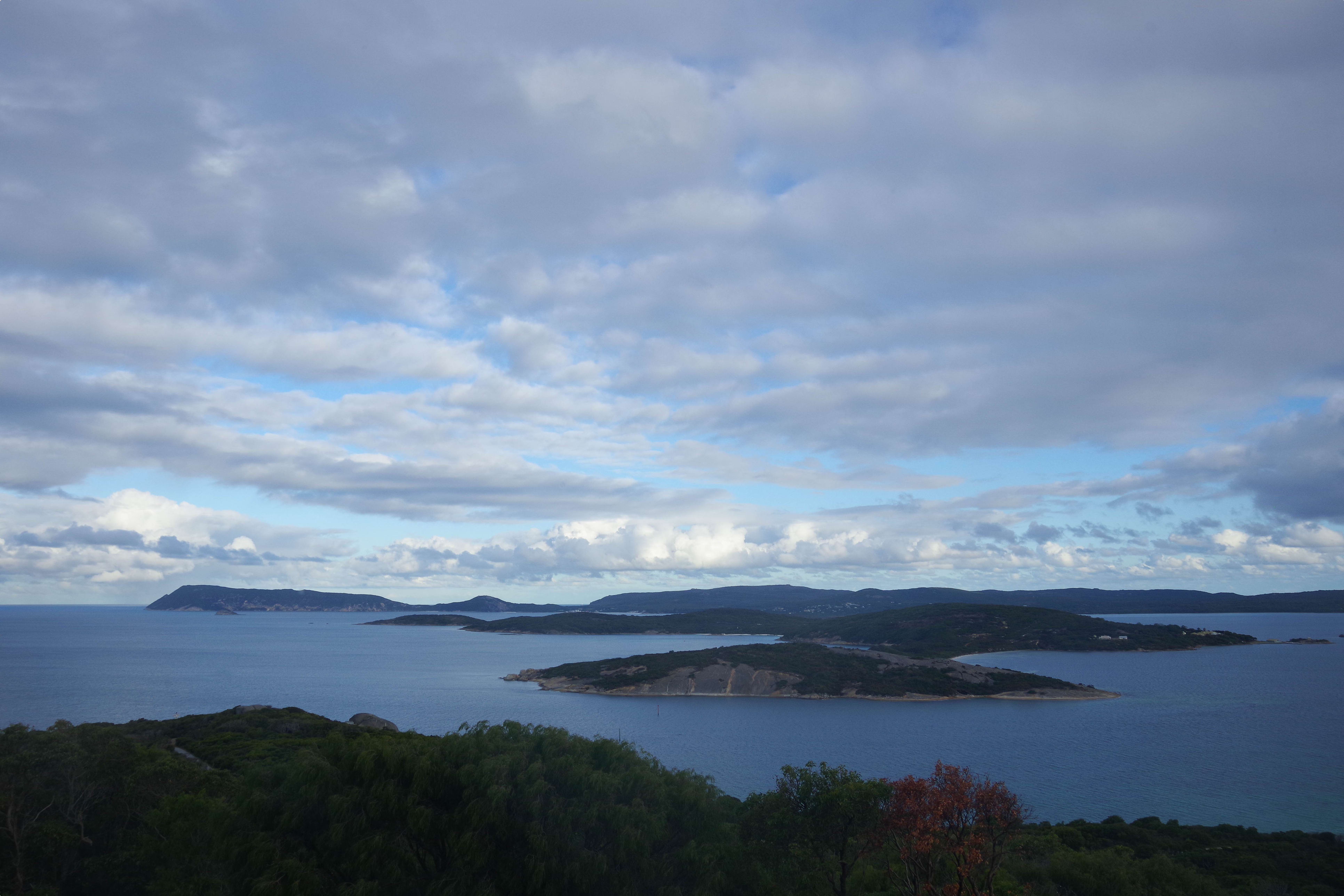
Archaeological Sites on Traditional Lands
For thousands of years, the indigenous Noongar people of the Wagly Kaip region have shared and cared for country. This region includes the landscapes of the Stirling ranges, Mt Madden, and deep bays, forests and extensive plains filled with a wide range of natural resources. Rivers and waterways include the Kalgan, King, Stokes, Fitzgerald, Wellstead, Gordon, Pallinup, and Cullum Inlet.
The earliest record of Aboriginals in this region, and the wider south coast of Western Australia, comes form the lower reaches of the Kalgan River. Artefacts unearthed at the Upper Kalgan in the late 1970s by the archaeologist Dr William Ferguson reveal the history of Aboriginal inhabitancy dates back at least 19,000 years. The excavations, which covered only a few square metres, discovered nearly 7,000 rock chips and flake artefacts, showing clearly the site was used for gatherings across generations.
Even older prominent archaeological sites have been found in Western Australia. Devil’s Lair at Margaret River, for example, is recorded as being 33,000 years old. A site at Exmouth has been dated at 34,000 years. And the Upper Swan boasts a site that is double the age of the Kalgan site.
Within the Wagly Kaip region, the people used the coastline, as well as the rivers, swamps, and vegetation beyond it. Tangible reminders of their inhabitancy remain today in the extensive complexes of stone structures or alignments at various locations thought to have been used by hunter-gatherer groups as fish traps. Key sites are located on the foreshores of Wilson Inlet and Broke Inlet, two 50km² basin like estuaries on the southern coast of Western Australia, and most prominently further east at Oyster Harbour between the Kalgan and King Rivers in Albany.

The Albany Fist Traps date back an estimated 6,500-7,500 years and is just one of several places where the local Menang group of the Noongar people utilised the marine and estuarine resources of the Albany area. Built of rock and wood on the northern shoreline of Oyster Harbour, the traps tell of clever, opportunistic hunters. Constructed on tidal flats, the semi-circular structures would confine fish caught as the tide moved out. The Aboriginals would then heard the fish into brushwood pens, where they trapped to be speared at leisure.
This area would have been used extensively as a hunting ground. The fish traps were used for around six months of the year during the warmer months, before migrating inland on the onset of winter to areas around the Stirling Ranges where the was more shelter and warmth. The area was also a corroboree ground, where marriages were arranged and everything came together.
Early European Observations of the Fish Traps
The earliest European descriptions of the stone structures in Albany refer to them as tidal weirs, though apparently the observers did not see them in use. The first recording was in 1791 by George Vancouver, writing of finding “fish weirs” in a river near the harbour. He describes them as being “constructed with lose stones, others with sticks and stumps of wood”. He observed them at low tide but supposed “when the rain or other causes should extend the rivulet beyond its present bounds… these humble contrivances might arrest some small fish”. However, he was evidently unimpressed, considering them “the sorry contrivance of the wretched inhabitants of the country”.
From his report, it is clear that barriers of brushwood or timber once surmounted the emplaced stones to create higher walls. None of the structures could have retained fish with only the walls than they have at present. This is further evident from the details of the weirs included in the account of the naval surgeon and botanist Archibald Menzies, who accompanied Vancouver:
“They consist of a row of small boughs of trees struck close together in the sand about two or three foot and kept close at the top by cross sticks along both sides fastened together with small withies and along their bottom some stones to prevent the fish escaping.”
Nicolas Baudin next described the fish traps during his expedition of 1803. Unlike Vancouver, Baudin appeared impressed by both the construction and the Noongar’s ingenuity: “ proof”, he wrote, that the “natives were not without intelligence”.
Fifteen years later, J.S. Roe, a lieutenant aboard P.P. King’s Mermaid at anchor in King George Sound, reported eleven weirs on the flats and shoals between the two rivers while exploring the foreshore of Oyster Harbour. One trap was more than 100 yards in length and projected 40 yards in a crescent shape out to sea.
In his notes, King is explicit about the use of these weirs through tidal action. He writes of “stones placed so close to each other as to prevent the escape, as the tide ebbed, of such fish as had passed over at high water”. He goes on to describe Tulicatwalè, a Noongar man, who “was to watch the weir all night to prevent the fish from escaping when the tide ran out and at a certain period to stop up the entrance with bushes”.
From here, Interest in the fish traps seemed to have waned, both from the Europeans and the Noongar. There are no reports of the traps used after the British annexation of the territory in 1827.
The Fish Traps Today
Although no longer in use, some of the fish traps at Oyster Harbour reported by the Early European explorations are still intact and can be seen at low tide. They consist of eight separate semi-circles of low, loose stone walls lying along the shore. Thousands of closely placed, mainly cobble-sized stones (generally about 15 cm in the smallest dimension) make up these walls.
The two well defined medium-sized stone semi-circles are approximate 47 m long and 27 m wide, and 62 m by 29 m respectively. In some places the walls have collapsed and the stones are spread out on the sand. The walls of the most complete trap reach about 40cm in some parts. All the stones in the traps are of a dark, almost black, lateritic material found naturally in fair abundance on the surrounding shore.
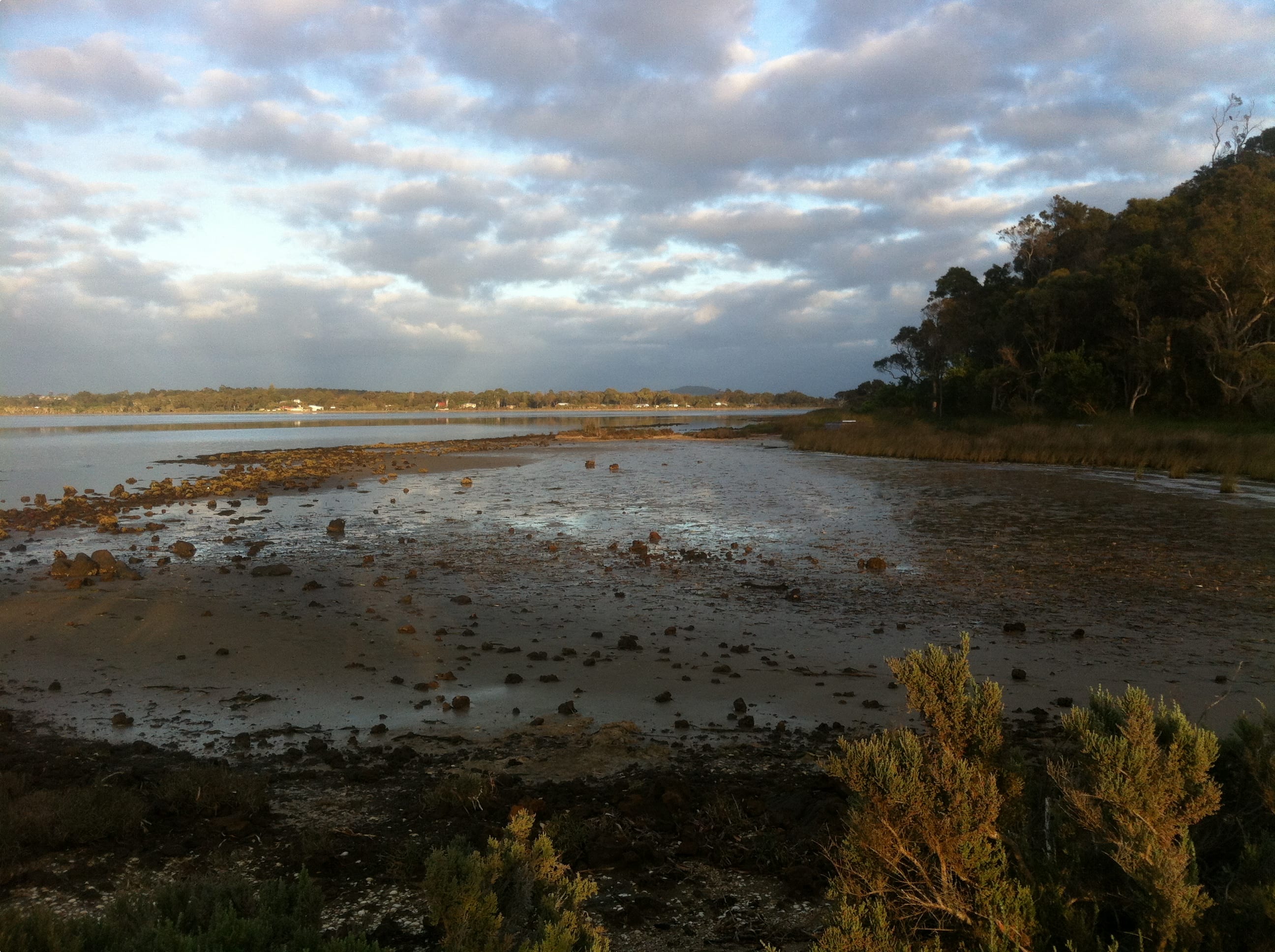
Preservation of the Fish Traps
The site was included in the National Trust of Australia in 1966 and was one of the first sites to be declared a protected area under the Aboriginal Heritage Act 1972 when it was gazetted in 1973.
At the request of local traditional owners, archaeologists carried out a series of minor excavations at the site between 2000 and 2006 to determine how the structures had been constructed and their age. Collections on the rocks such as barnacles allowed them to approximately date them to after the mid-Holocene sea level rise, as is the case with other stone weir or trap complexes on the Southern Ocean coast.
Following concerns that the traps were becoming irreversibly damaged from recreational boating and fishing in the area, the site was returned to the Menang people in 2009 to preserve and protect its heritage. A $170,00 project was then initiated in 2011 to pass on knowledge about the sacred spot following the discovery that hundreds of stones had been removed. This project, completed in 2015, saw the construction of a cultural shelter, boardwalk and interpretation sign, all highlighting the historical Aboriginal connection to the area.
In the future the traps will be one of several Aboriginal sites that will be linked to form the Kinjarling Cultural Pathway. In the meantime, some local Aboriginal groups are keen to restore one of the eight weirs to working order to use it to demonstrate traditional practice.
Tour of Aboriginal Australia
Travellers with an interest in learning more about the Aboriginal heritage of Australia may want to check out our various outback Australia tours.
These include visits to:
- The Brewarrina Fish Traps in outback Queensland;
- Archaeological sites including the Madjedbebe rockshelter and the extensive collection of ancient Aboriginal rock art at Kakadu National Park as part of our tour of Kakadu and Darwin
- The ancient indigenous sites including Lake Mungo and the Budj Bim Cultural Landscape as part of our tour of the Southern States of Australia;
- The important cultural site of Wilpena Pound on our tour of the Flinders Ranges;
- The ancient rock art in the Kimberley, Western Australia;
- Uluru and Kata Tjuta in the Northern territory.

Every Odyssey guided tour is designed especially for mature and senior travellers, who want an authentic and informed experience of their destinations. Our tours aren’t the typical tourism Australia holiday – Blue Mountains, the Great Barrier Reef, and the penguin parade on Port Phillip Island. Instead, we pride ourselves on getting of the beaten path and making you think about Australia and New Zealand in new ways. We move in genuinely small groups – usually 6-12 per tour – and all tours are cost-inclusive, encompassing accommodation, attraction entries, and transport. For more information, click here, and head to this page to make a booking.
Articles about Australia published by Odyssey Traveller:
- Uncovering the Ancient History of Aboriginal Australia
- Aboriginal History and Culture of Kakadu National Park
- Aboriginal Land Use in the Mallee
- Understanding Aboriginal Aquaculture
- The Kimberley: A Definitive Guide
External articles to assist you on your visit to Australia:
- The Story of Aboriginal Art
- Indigenous songlines: a beautiful way to think about the confluence of story and time
- The Dreaming
- Meaning of land to Aboriginal People
- Aboriginal History
We acknowledge Aboriginal and Torres Strait Islander peoples as the First Australians and Traditional Custodians of the lands where we live, learn and work. We pay our respects to Elders past, present and emerging.
Related Tours

days
Apr, May, Jun, Jul, Aug +3Small group tour exploring Alice Springs and Uluru-Kata Tjuta National Park
Visiting Northern Territory
Explore and learn about historic Alice Springs, The MacDonnell ranges, and Uluru-Kata Tjuta National Park. This escorted small group tour for mature and senior travellers, travelling as a couple or solo travellers also visits the Hermannsburg Lutheran mission plus Henbury meteorite site learning about the Aboriginal outback and contemporary art.

days
Apr, Jun, Aug, Nov, Mar +2Exploring Alice Springs and Uluru-Kata Tjuta National park by Motorbike
Visiting
Explore on a Motorbike tour in the Outback and learn about historic Alice Springs, The MacDonnell ranges, and Uluru-Kata Tjuta national park. This escorted small group Motorbike tour for mature and senior travellers, travelling as a couple or solo travellers also visits the Hermannsburg Lutheran mission plus Henbury meteorite site learning about the Aboriginal outback and contemporary art.

days
Jun, Jul, Sep, Feb, Mar +1Darwin and Kakadu small group tour
Visiting Northern Territory
Explore and learn as part of a small group tour for seniors on this package tour to Darwin and Kakadu National park, a UNESCO world heritage site. This program also visits Arnhem land. Our focus is on ecology, landscapes and history on this 14 day program in the far north of the Northern Territory.

days
Mar, May, Aug, Sep, Oct +2Small group tour of World Heritage sites and more in the Southern States of Australia
Visiting New South Wales, South Australia
Discover the World Heritage Sites of the southern states of Australia travelling in a small group tour. A journey of learning around the southern edges of the Murray Darling basin and up to the upper southern part of this complex river basin north of Mildura. We start and end in Adelaide, stopping in Broken Hill, Mungo National Park and other significant locations.
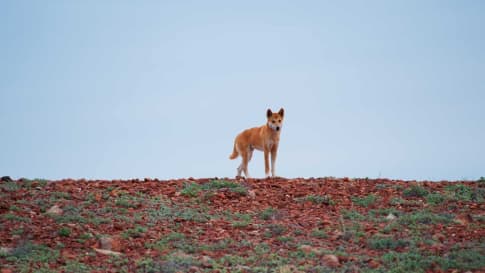
days
Apr, May, Jul, Aug, Oct +2Small group tour of Australia's Flinders ranges
Visiting South Australia
Escorted small group tour of the Flinders range in South Australia from Adelaide. Learn about Coober Pedy, Wilpena pound and water system of Lake Eyre as we explore and learn also about the history of the people who explored the Flinders.
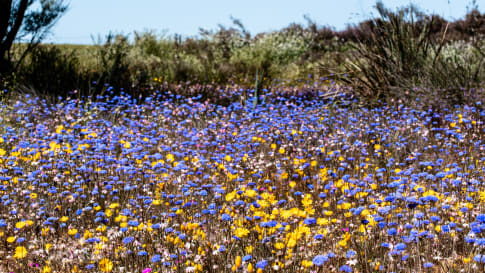
15 days
Aug, SepWildflowers tour of Western Australia
Visiting Western Australia
Escorted small group tour for senior and mature travellers as a couple of solo traveller. Upto 12 people of WA's Wildflower regions including Esperance and the Fitzgerald river National park. Local guides and program leader share knowledge about this fascinating region whilst in bloom.
From A$12,250 AUD
View TourArticles

Ancient Aboriginal trade routes of Australia
Ancient Aboriginal trade routes of Australia Trade was a central part of life for Aboriginal people prior to the British settlement of Australia. Trading routes criss-crossed the nation, dispersing goods, information, technologies and culture thousands…
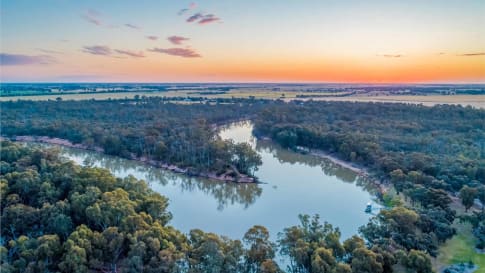
Appreciating Australian River Systems
Appreciating the linking of the river network into the Australian, history, culture and landscape on a small group tour for mature and senior travellers of couples or solo travellers is an integral part of understanding the continent of Australia and Aboriginal settlement.

The Australian Outback: A Definitive Guide
Explore learn and consider what is the outback in this article. For mature and senior travelers considering joining a small group package tours into the outback to see, learn and explore about this unique place, not only the landscape but the Aboriginal approach to living. On each of the tours for couples and the single traveler you learn something different but fascinating, from Outback Queensland, the Flinders, Broken Hill and the Kimberley and the wildflowers all contribute to this question, what is the outback?

Understanding Aboriginal aquaculture
Aboriginal communities had the ability to harvest fish some 20,000+ years ago. Creating major centres of trade and cultural exchange, and supported permanent communities. Discover and learn more on a escorted small group package tour to Victoria, South Australia & Queensland for mature and senior travellers, couples and solo travellers interested in learning.
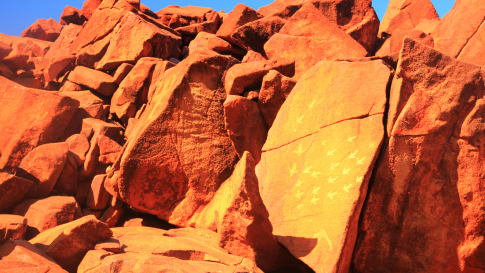
Aboriginal Stone Arrangements
Aboriginal stone arrangements are a form of rock art deliberately placed in position by Indigenous Australians and associated with spiritual ceremonies or utilitarian purposes. This article for mature and senior travellers provides and couples and solo travellers with and understanding and appreciation of the Ancient historic landscapes they are travelling though on a small group tour.
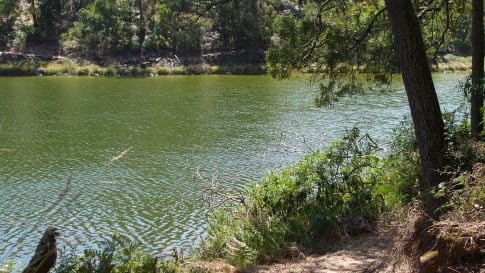
Budj Bim Cultural Landscape, Victoria
Article for escorted small group tour about this program visiting UNESCO World Heritage sites in Victoria, South Australia & NSW. Exploring and learn about Budj Bim cultural landscape for mature and senior travellers .

Budj Bim Eel Traps, Victoria
Article supporting small group tours for senior couples and solo travellers of significant Aboriginal farming activity and aquaculture. A UNESCO world heritage site complementary to Mungo man and lady and more. The eels farmed were then a trading asset taken along songlines (trading routes.) forming part of kinship rituals.

Wildflower Way, Western Australia
Wildflower Way itself runs 309 kilometres from Dalwallinu, north of Perth, going north and west to the coast of Geraldton, covering 21 meaningful sites developed to educate travellers. This small group tour for mature travellers of Wildflowers visits wildflower way.
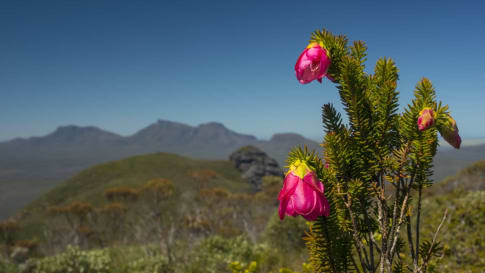
Wildflowers of Mt Barker and Stirling Range, Australia
The town of Mount Barker and the nearby Stirling Range National Park are one of the best places in Western Australia to see the state's incredible collection of wildflowers, that we visit on this small group tour of Western Australia Wildflowers.

Why did the British settle Australia?
Escorted small group tours for mature and senior travellers that promote aboriginal and colonial history discussion on tour. For couples and solo travellers interested in learning about Aboriginal history and the colonial explorers across the states.
